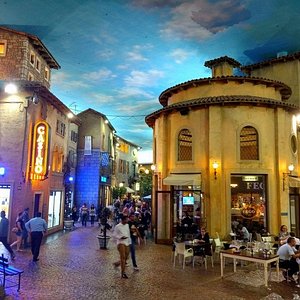Little Known Questions About Johannesburg North Attractions.
Wiki Article
The Basic Principles Of Johannesburg North Attractions
Table of ContentsThe 9-Minute Rule for Johannesburg North AttractionsMore About Johannesburg North AttractionsThe Ultimate Guide To Johannesburg North Attractions4 Easy Facts About Johannesburg North Attractions ShownThe Buzz on Johannesburg North Attractions3 Easy Facts About Johannesburg North Attractions Explained
The city owes its place to the existence of an also extra precious source: gold. The city grew on the edge of the Witwatersrand Main Reef, a subterranean stratum of gold-bearing quartz-silica corporation that arcs for numerous miles underneath the Highveld. The majority of the gold mines in the city ceased procedure in the 1970s, yet in its day the Witwatersrand gold sector made up greater than 40 percent of the world's yearly gold manufacturing.Johannesburg has a pleasant environment. The city appreciates about eight hours of sunlight per day in both winter months and summer season.
What rainfall the city receives falls almost solely in the summertime months, commonly in spectacular late-afternoon electrical tornados., where several citizens still rely on coal for fuel.

Everything about Johannesburg North Attractions
The equilibrium of the city is inhabited by whites. Accommodation differs in character and high quality. Soweto is notorious for its unlimited rows of municipally built, two-room matchbox homes, yet it likewise has a few thriving enclaves as well as bursting squatter camps, where 10s of thousands live without water, electricity, or sanitation facilities.Physical development, although somewhat restricted by transportation, proceeded rapidly as migration to South Africa, and Johannesburg in particular, boosted drastically.
The majority of bad suburbs were mixed, with inadequate blacks and whites cohabiting, although the well-off residential areas were usually reserved for whites. This changed with the political election of the National Party in the 1948 elections, who started to formalise the system called discrimination. Apartheid formally marked which suburban areas each race might reside in under the Team Areas Act.
The previous system of eleven numbered areas was reorganised in 2006. Marshalltown, as seen from the top of the Carlton Centre. The M1 and M2 run behind the structures, and the southern residential areas prolong past the freeway border. The central city of Johannesburg lies within the city's Region F. The approximated population of the region is 200,000, [] but the number of individuals staying in the central city on a casual basis is unidentified, as many are illegal aliens. A lot of higher-income homeowners and white people have relocated to the northern suburban areas and have actually been replaced by lower-income black people. The unemployment, education and learning, and age accounts of the area are all unknown, due to the trouble of acquiring dependable details concerning the area.
Fascination About Johannesburg North Attractions
Centred on the CBD, the region consists of the residential areas of Yeoville, Bellevue, Troyeville, Jeppestown, and Berea to the east. To the west it infects Pageview (Johannesburg North attractions) and Fordsburg. There are tiny enterprise zones to the south, such as City West-Denver and Benrose. Around 800,000 commuters pass with the central city every day, and it functions as a local buying node for visitors from the southern suburbs. Yeoville and Bellevue have a mix of apartment and solitary domestic devices on tiny great deals. The region is located on a mountainous divide that ranges from eastern to west. One of the most obvious geographical feature is Observatory Ridge, which is called for the big observatory located on it. The leisure rooms are no more made use of, because of security issues.
The Definitive Guide for Johannesburg North Attractions
R. Tambo International Flight Terminal). The eastern suburban areas are a few of the earliest areas of Johannesburg, there are big neighborhoods of Jewish and various other European histories, most of the populace is English talking. There are three golf links along with a number of safeguarded ridges with viewsites. There are imp source numerous strong and up-market enjoyment and buying locations in the east such as the Eastgate Mall and the Greenstone mall.The navigate to this site location is primarily made up of old "matchbox" residences, or four-room homes built by the federal government, that were developed to offer economical holiday accommodation for black workers during racism. Soweto is an abbreviation, standing for "South Western Townships". Road after street around is lined with matchboxes; nevertheless, there are a few smaller sized locations where prosperous Sowetans have actually constructed homes that are much more similar in stature with those in more upscale suburbs.
Hostels are one more noticeable physical attribute of Soweto. Originally built to house male migrant workers, many have been boosted as homes for couples and family members. The N1 Western Bypass skirts the eastern boundary of Soweto. The residential area was not traditionally permitted to create work centres within the area, so almost all of its homeowners are travelers to various other parts of the city.
The Best Strategy To Use For Johannesburg North Attractions
The property locations in the north suburbs are generally official, with no considerable locations of informal real estate, or real estate that does not have a long-term structure. This is a well-known area, there is a fad of land usage change from household to commercial, specifically along major arterial roadways and around well-known nodes.The area is well connected to road networks, especially along the north-south axis formed by the M1 and N1. Roadways to the eastern and west are less well developed, as there are content no freeways travelling in that direction. Towards the northern border of the city, the density of growth lowers, leaving huge areas of undeveloped land around Midrand.
The Basic Principles Of Johannesburg North Attractions
, which is situated on a hill forgeting the internal city and Hillbrow.Report this wiki page